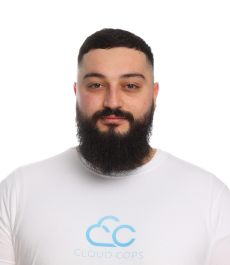Observability Consulting
Empowering Insights into System Health and Behavior
In the realm of cloud-agnostic applications and complex IT environments, the need for a holistic view into systems is crucial. Observability, as a concept, goes beyond mere monitoring. It delves deeper, offering insights into the why and how of system behaviors. At CloudCops, we recognize the importance of the four pillars of observability — Metrics, Traces, Logs and Visualization. Our Observability Consulting services are designed to guide businesses in selecting and implementing the right tools, tailored to their unique needs.
Talk to an Expert
Our Experience
Unraveling the Intricacies of Observability's Pillars
Beyond Data: Crafting a Symphony of Metrics, Traces, Logs and Visibility
The holistic perspective that observability grants IT teams is vital, especially in the realm of today's intricate software architectures. Observability’s four foundational pillars interweave to narrate a comprehensive story of your systems.
Determine RequirementsMetrics
Think of metrics as the pulse of your system. They provide quantifiable snapshots, allowing you to gauge system health and performance instantaneously. Metrics offer a broad overview—capturing system load, memory usage, response times, error rates, and much more. They are often the first line of defense, sending alerts when anomalies are detected. While they are aggregated data points, the granularity can vary based on the need, from high-level system metrics to fine-grained application-specific ones. Modern tools allow these metrics to be scaled across thousands of nodes and services without losing precision. Prometheus, for instance, shines in real-time data collection and alerting, especially in Kubernetes environments. Datadog, on the other hand, is cloud-centric, offering expansive integrations, ensuring comprehensive coverage across platforms and services.
Traces
If metrics are the pulse, traces are the blood flow, revealing how requests move across various components, helping to pinpoint inefficiencies or failures. Traces are especially crucial in microservice architectures where a single user request might pass through multiple services. They provide context by visualizing this journey, highlighting bottlenecks, or failures. Each trace comprises multiple spans, each corresponding to an operation in the system. This granular view is invaluable when multiple teams need to collaborate, as it clearly demarcates the responsibility and impact of each service. For this, there are multiple tools we can use; Jaeger excels in end-to-end trace visualization, while Grafana Loki uniquely integrates logs within the tracing context of Grafana Tempo, enriching the data. ELK Stack provides advanced trace analytics, and OpenTelemetry is becoming the standard for unified observability, covering both traces and metrics.
Logs
Consider logs as the detailed journal of your system, recording every event, error, and transaction in detail. Logs provide the raw narrative, offering the deepest insights. Whether it's a failed transaction, a security breach, or a system crash, logs capture these events in detail, making them invaluable during in-depth diagnostics. Modern logging practices emphasize structured logging, where logs are stored in a consistent, machine-readable format. This structure makes querying and analysis significantly more efficient. ELK Stack (Elasticsearch, Logstash, Kibana) stands as a dominant figure in centralized logging, offering powerful search and visualization capabilities. Grafana Loki, designed to work seamlessly with Kubernetes, ensures logs are contextually integrated with metrics and traces, visualizing everything in Grafana. Promtail, working in tandem with Loki, ensures efficient log collection and forwarding.
Visualization
Amidst the vast sea of metrics, traces, and logs, visualization tools emerge as lighthouses, guiding teams through data and transforming raw numbers into actionable insights. Visualization is not merely about displaying data; it's about presenting it in an intuitive, comprehensible manner, fostering quicker decision-making. Grafana stands out with its robust, customizable dashboards and its capability to aggregate data from numerous sources. Datadog, besides its metrics prowess, provides rich visualization options, ensuring teams can perceive patterns and anomalies at a glance, offering a complete visualization platform. Kibana, part of the ELK Stack, offers powerful visualization capabilities for logs and metrics, ensuring that the intricate details of your system are transformed into understandable visuals.
Alerting
Alerting acts as the critical response mechanism in an observability framework, transforming insights from metrics, logs, and traces into actionable notifications. Effective alerting systems promptly inform relevant teams about anomalies, potential issues, or system failures, facilitating swift action. These alerts are typically configured based on predefined thresholds or patterns, ensuring that teams are not overwhelmed by noise but are alerted to genuine concerns. Tools like Prometheus are known for their robust alerting capabilities in real-time, while solutions like Grafana offer integrated alerting features, ensuring a cohesive response to any operational irregularities.
In essence, observability's pillars, combined with potent alerting, equip businesses to navigate the complexities of modern IT environments, ensuring optimal performance, reliability, and user satisfaction.
System Insight
Without Observability
Limited understanding of system behavior; reactions are mostly based on assumptions or post-failure analyses.
With Observability
Comprehensive real-time insights into system behavior, performance, and user interactions, allowing for proactive interventions.
Anomaly Detection
Without Observability
Reliance on user reports or catastrophic failures to become aware of issues. Slow response to emerging problems.
With Observability
Immediate identification of anomalies using metrics tools like Prometheus and Datadog. Swift action can be taken before users are significantly impacted.
Troubleshooting
Without Observability
Time-consuming and based on trial and error. Difficulty in pinpointing root causes.
With Observability
Efficient root cause analysis with traces, facilitated by tools like Jaeger, Grafana Tempo and OpenTelemetry. Issues are resolved faster, minimizing downtimes.
System Documentation
Without Observability
Scattered, outdated, or non-existent logs make it hard to understand historical events or changes.
With Observability
Detailed and structured logging using ELK Stack or Grafana Loki ensures that every system event is chronologically and contextually recorded.
User Experience
Without Observability
Unplanned outages and performance lags. Users often face issues that remain undetected by the system administrators.
With Observability
Improved system performance and fewer disruptions, leading to enhanced user satisfaction. Observability ensures systems meet user expectations consistently.
Collaboration
Without Observability
Teams work in silos, with limited understanding of how their actions impact the broader system.
With Observability
Visualization tools like Grafana, Datadog, and Kibana provide a unified view, fostering collaboration. Teams understand the system holistically and can coordinate efforts more effectively.
Operational Costs
Without Observability
Frequent unplanned outages and prolonged troubleshooting lead to higher operational expenses.
With Observability
Reduced outages and faster issue resolution mean decreased operational costs. Predictable system behavior allows for better budgeting and resource allocation.
Decision Making
Without Observability
Based on limited data, gut feelings, or reactive approaches.
With Observability
Empowered by comprehensive data from all system facets, leading to informed, proactive decisions that align with business goals and user needs.
Our Observability Consulting Services
Turning Data into Decisions, Visibility into Vision.
Navigating the intricate nuances of modern IT infrastructure can be daunting, especially without the right tools and expertise. CloudCops' Observability Consulting Services ensures that you're not just collecting data, but also deriving actionable insights from it.

With CloudCops at your side, observability isn't just a technical undertaking; it's a strategic advantage. We ensure that you're not just reacting to issues but preempting them, creating an IT ecosystem that's resilient, efficient, and business-aligned.
An Innovative Tech Stack Driving Your Success
At CloudCops, we consistently harness the latest Open Source and Cloud Native tools to deliver innovative, efficient, proven, cost-effective solutions. Dive into our advanced technology offerings.
Translated from German
Testimonials

Nils Haberland Group CIO, Managing director
Salih has been a key player in the engineering and implementation of our DevOps setup from its initial stages. His expertise in Infrastructure as Code and integration of Open Source Tools have been fundamental to constructing our cloud infrastructure and roll out methods. We have greatly changed our view on devops, increased control of changes on infrastructure and improved collaboration. His commitment to a GitOps and Cloud-Native mindset aligns with our corporate objectives, reinforcing our strategic direction. Additionally, he has been proactive in sharing his knowledge, greatly benefiting our team's development and cohesion.

Rolf Wendolsky CEO
Salih is a very efficient and versatile developer. He set up a new Kubernetes system in AWS for us. He also developed and deployed an application to automatically update the invoice and cost preview for us and our customers. Furthermore, he has been working very successfully for one of our customers for about a year now, especially for DevOps engineering activities.

Dilan Barzingi CEO
With Mr. Kayiplar, we have had a terrific colleague and partner working with our customer. His performance is and remains very professional. We want to maintain a long-term partnership and can recommend Mr. Kayiplar to other service providers and colleagues. We are very grateful for the great collaboration and look forward to further projects with Mr. Kayiplar.

Uwe Segschneider Manager
I have the pleasure of working closely with Salih on our Kubernetes infrastructure. Salih is one of the most talented DevOps engineer I have ever worked with. Salih combines technical expertise with an incredible passion for continuous integration, automation, and cloud infrastructure, and is grounded in the necessary GitOps mindset.




